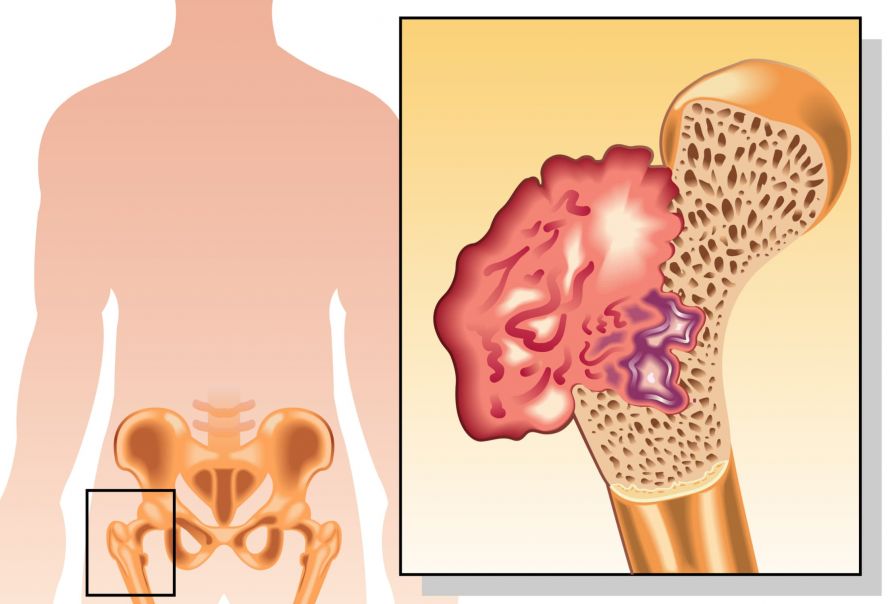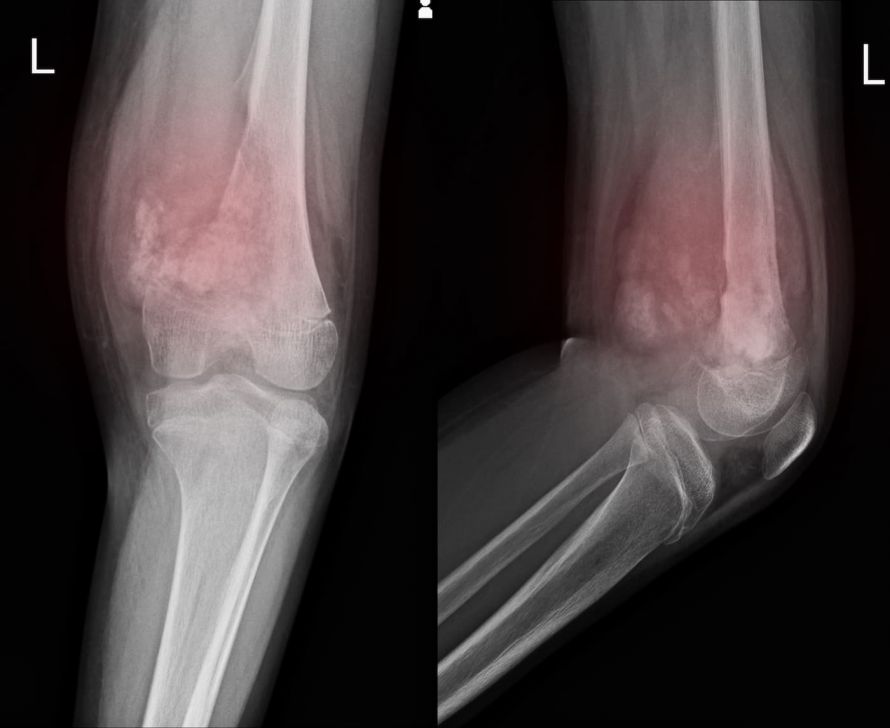The most common types of malignant bone cancer are:
- Osteosarcoma (in the bone): Primarily affects male adolescents between the ages of 10 and 20.
- Ewing's sarcoma (in the bone marrow): Affects boys and girls equally and occurs more frequently between the ages of 10 and 15.
- Chondrosarcoma (in the cartilage): Usually affects adults between the ages of 30 and 50.
Osteosarcoma of the femur © rob3000 | AdobeStock
Primary bone cancer, i.e. cancer that develops directly in the bone tissue by itself, is comparatively rare. In Germany, only about 700 new cases occur each year. This corresponds to about one percent of all malignant cancers.
However, bone metastases resulting from other cancer sites in the body (secondary bone cancer) are significantly more common. Tumours of the lungs, breast, prostate, kidneys and thyroid gland in particular spread to the bones. Metastases can already be detected in aggressively growing tumours before the initial disease itself becomes symptomatic. Tumour diseases usually take several years to develop. Secondary bone cancer therefore occurs mainly in the second half of life.

Bone metastases in the thigh bone
Doctors do not call benign cell changes in the bones cancer, but benign bone tumours. The benign bone tumours include
- osteoma,
- osteoid osteoma and
- osteoblastoma.
The causes of bone cancer are not yet known in detail. However, since malignant tumours in the bones often occur during childhood or puberty, doctors suspect that growth-related and hormonal factors play a role. Other risk factors for the development of bone cancer include
- a genetic predisposition,
- the bone disease Paget's disease
- previous radiotherapy or chemotherapy due to another disease.
Patients suffering from retinoblastoma (retinal tumour) also have an increased risk of bone tumours.
The symptoms of bone cancer are usually rather non-specific. They may include
- Pain in the affected area,
- Swelling of the skin and
- associated movement pain.
However, which signs appear ultimately depends on the type, size and location of the bone tumour.
Bone cancer manifests itself rather non-specifically through pain in the affected area © 9nong | AdobeStock
Osteosarcoma occurs more frequently in the long bones of the upper arms or thighs. It usually affects the area of the bone where the bone shaft merges with the spherical end of the bone. Patients observe painful swellings that increasingly impair the mobility of the affected limbs. The malignant tumour causes the bone to lose strength. Therefore, even normal stress can lead to a bone fracture. Such spontaneous fractures without major external force are always suspicious.
The symptoms of Ewing's sarcoma are similar to those of other bone tumours. Pain and swelling in the affected area indicate a disease. However, this is accompanied by a strong feeling of illness with fever. The signs are similar to those of osteomyelitis, which is why it is often mistaken for this disease. Ewing's sarcoma is particularly common in the shaft of the long bone in the leg or in the pelvic bone.
Chondrosarcoma, on the other hand, hardly causes any pain. It is particularly common in the pelvic area and the thigh or shoulder region.
In the case of complaints that suggest bone cancer, a detailed medical history is taken first, followed as a rule by an X-ray examination. Specialists for imaging examinations are known as radiologists. If the suspicion of a malignant bone tumour is confirmed, then
X-ray of the knee shows malignant bone tumour on the thigh bone © Richman Photo | AdobeStock
In order to find any bone metastases, an additional scintigraphy may be necessary. This is an imaging procedure in nuclear medicine which makes the tumour cells directly visible.
A blood test will provide further information. If certain enzymes are elevated, the suspicion of osteosarcoma or Ewing's sarcoma, for example, is strengthened.
However, the final diagnosis of a benign or malignant bone tumour can only be made by a biopsy. The doctor takes a tissue sample from the bone with a needle. A pathologist then examines this sample in the laboratory.
Taking a tissue sample from the bone to confirm the diagnosis of "bone cancer" © Алексей Доненко | AdobeStock
The treatment of bone cancer depends on the type of tumour as well as its spread. Typically, oncologists advocate a combination therapy. The options include:
- Operation
- Chemotherapy
- Radiation therapy
When the tumour is surgically removed, the surgeon removes whole bone parts and possibly also surrounding tissue. In particularly severe cases, surgeons sometimes even have to resort to amputation. If the surgeon removes only small parts of the bone, incorporated foreign materials take over the stabilisation. These are screws and plates. In some cases, a connecting frame outside the body is also used. In the case of very large defects, the transfer of autologous bone tissue (often from the iliac crest) may be necessary.
In osteosarcoma, which occurs more frequently in the long tubular bones, a combination of chemotherapy and surgery is used in most cases. The first step is chemotherapy to shrink the bone tumour and kill the micrometastases. This is followed by the operation, during which the surgeon tries to remove the remaining bone tumour as completely as possible. Following this, chemotherapy is used again. In addition, drugs can help stimulate the immune system so that the body can fight the cancer more efficiently. Radiation therapy is usually not an option, as osteosarcoma hardly reacts to ionising radiation.
Chemotherapy for bone cancer © Tyler Olson | AdobeStock
The same treatment procedure is used for Ewing's sarcoma. However, this type of bone cancer does respond to radiation, which is why radiotherapy is an important part of the treatment plan.
Unfortunately, chondrosarcomas are particularly difficult to treat because these bone tumours are very resistant to radiation. However, as there are currently no alternatives, the treatment of chondrosarcoma is still radiochemotherapy in combination with surgery. Despite the extremely high dosage of chemotherapy, some chondrosarcomas do not respond to the therapy at all. Doctors can then only provide palliative care for the patients.
Surgeons usually remove benign bone tumours surgically as well. In the case of slow-growing tumours that do not cause any complaints, the treating doctors often even wait. In the case of osteochondroma, on the other hand, rapid surgery is very likely. The bone tumour, which is benign in itself, can degenerate and become bone cancer.
The prognosis for bone cancer depends on
- the type of tumour,
- the size and spread as well as
- the tumour stage.
Furthermore, even after successful treatment, it cannot be ruled out that the tumour will form again, a so-called recurrence.
In the case of osteosarcoma, the chances are particularly good if the disease is detected at an early stage. If no metastases have formed yet, the chance of survival five years after diagnosis is over 60 percent. The prognosis is much less favourable if metastases have already formed.
The same is true for Ewing's sarcoma, although the death rate within the first five years after diagnosis is even a little lower.
Chondrosarcoma patients have a particularly poor prognosis. Doctors speak of a bone cancer survival rate of less than 50 percent up to five years after diagnosis for the severe disease in the cartilage.
















